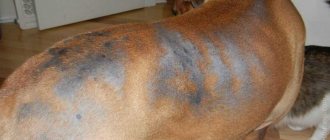Causes
Sometimes dogs experience fainting - this is a state of temporary memory loss and rapid self-recovery. They are caused by a temporary decrease in cerebral blood supply, as a result of which oxygen delivery to the brain deteriorates. But there are a number of other reasons that also cause fainting. Let's take a closer look at what causes a dog to lose consciousness.
Neurological
- epilepsy;
- dysfunction of the brain.
Cardiological
- cardiac arrhythmia;
- ventricular tachycardia;
- ventricular fibrillation.
Often this condition can be caused by poisoning, so try to closely monitor what your dog eats. There are times when a collar that is too tight blocks access to oxygen. Therefore, never tighten it too tightly. Fainting or syncope is accompanied by nausea, dizziness, loss of coordination, slow heart rate, and cold paws. But do not confuse fainting with loss of strength.
With this diagnosis, the dog may be completely immobilized, but conscious. The cause of weakening is severe hypotension or anemia, shock, heat stroke, bleeding. It is not recommended to treat yourself; at the first symptoms you need to show the animal to a doctor.
What to do if your dog loses consciousness
If oxygen does not reach the brain for a long time, the animal may die. Therefore, if you see your dog feeling unwell, if he has become motionless, be sure to provide first aid. What you need to do to help your pet:
- Immediately remove the collar, clothing, if any, and place the animal on either side.
- Remove the tongue from the mouth, make sure that all airways are open.
- To increase blood flow to the brain, place your head lower than your body.
- As soon as the animal is conscious again, give it cold water.
Check the heartbeat by placing your palm just above your dog's heart. You need to understand whether it is beating fast or slow. This information will help the called veterinarian determine as accurately as possible whether the condition is related to heart problems. If necessary, perform a cardiac massage. To do this, the dog must lie on its side.
For large dogs, press with your palms in the heart area, and for small dogs with your thumb. It is necessary to stimulate the heartbeat by squeezing the ribs. When pressing, control the force so as not to break the ribs. Every five presses, exhale into your dog's nose or mouth.
Important! It is recommended to film everything that happens to show the veterinarian. You can call a veterinarian at home or go to the clinic. An experienced doctor will immediately check the heart function for the presence of arrhythmia. But if the pet recovered quickly after the attack, then it does not suffer from arrhythmia.
At the clinic, a general blood test will be taken from the dog to check the functioning of the liver, kidneys, and blood sugar levels. If neurological abnormalities are detected, obtain a referral to a neurologist. The next step may be an MRI or spinal tap.
If the cause is a disruption of the cardiovascular system, then get a referral to a cardiologist. He may prescribe an ultrasound of the heart and a chest x-ray. After the examination, you will be prescribed medication.
- Surgery may be needed if tumors are detected.
- For anemia, blood transfusions are prescribed.
- If loss of consciousness is associated with a disruption in the supply of oxygen to the brain, a decrease in blood sugar, then glucose is administered.
- Medications may be given intravenously if the condition is very severe.
It’s good if you manage to get rid of the root cause, and fainting will no longer happen. But it happens that diseases become chronic, and then you will have to constantly monitor the dog’s health. Be sure to undergo regular examinations, listen to veterinarians' recommendations, provide proper care and a balanced diet.
Some dog owners notice that their dogs are more likely to lose consciousness during the summer. The cause is most often a lack of oxygen due to extreme heat. Under such conditions, the best first aid for your pet is a cool place and cold water. Write in the comments, have you ever had similar cases? What first aid was provided? What caused it?
Epilepsy in domestic dogs is a common disease that requires careful monitoring and proper diagnosis. If a pug has been diagnosed with this disease, it is necessary to quickly select an effective and competent treatment regimen that will help the animal return to normal life.
Since the health of a dog with such a diagnosis directly depends on the actions of its owner, responsible owners must have a complete understanding of what epilepsy is, know its signs and be able to provide first aid to their pet.
Symptoms and identification of causes
What can you observe about a dog that, for one reason or another, is prone to fainting episodes? There are no specific symptoms, but still predisposed pets often behave somewhat strangely:
- Sudden weakness. Fainting often begins with sudden weakness, which in some cases reaches ataxia (uncoordinated movements are observed). If your dog experiences anything like this, take him to the vet. It definitely won’t be superfluous.
- Some dogs develop “musical abilities” before fainting: the dog begins to squeal, whine, and wheeze. It looks scary, especially in those cases when, immediately before “falling over,” the animal’s eyes literally roll back into their heads.
- Stiffness of the neck muscles. Simply put, the muscles relax so much that the dog’s head literally “falls in.” Sometimes it looks as if the pet is having an epileptic seizure, after which the dog faints.
- In many cases of fainting or near-syncope, the dog will unknowingly empty its bowels and bladder. The dog should not be blamed for this, since he cannot control his actions at the moment the cerebral cortex is turned off.
As you can understand, there is no diagnosis of “fainting”. The veterinarian will have to figure out what kind of pathology causes the animal’s brain to switch off for a short time. To do this, you need to conduct a comprehensive examination of the dog:
- Medical history (including treatment history). A thorough physical examination is performed, with an emphasis on listening to the heart and lungs.
- Information is collected from the owners: what kind of illness did their pet have, whether he had any traumatic brain injuries, poisoning, or other serious pathologies.
- Blood pressure measurement. Moreover, this must be done not once, but several times a day, for at least three to four days. During this time, the dog will get used to the veterinarian, stop being nervous, and the research results will become more “adequate.”
- Blood tests are taken. In particular, it is very important to detect glucose levels (again, for at least three days). The fact is that hyperglycemia, characteristic of diabetes, can easily lead to fainting. Blood biochemistry is extremely important, since with the help of this test the veterinarian can determine hormone levels and find out the state of the animal’s endocrine system.
- Electrocardiogram (EKG). As in the previous case, not a single electrocardiogram is required, but several. It is very desirable (if possible) to use “removable” types of ECG devices that are attached to the animal and take readings around the clock. In this case, pathologies leading to fainting can be identified with high accuracy.
- Chest x-ray (chest x-ray). This way you can learn about morphofunctional pathologies of the heart.
- Pulse oximetry when there are signs of lung disease.
- If the dog lives or has lived in a country where there are at least isolated cases of heartworm infection, methods are used to identify these parasites.
- Ultrasound examination of the heart (echocardiogram).
What it is?
Epilepsy is a disease of the central nervous system, which is characterized by a paroxysmal course and periodic seizures in an animal, which are often accompanied by convulsions.
As a rule, this disease does not pose a mortal threat to pugs, but the quality of life is greatly reduced. An attack can begin at any moment; it is almost impossible to predict when and for what reason it will happen.
There is an opinion that epilepsy develops due to a pathology of the body's bioelectrical system, in which cells of the brain and nervous system are affected due to increased electrical activity.
During seizures, which can be accompanied by convulsions of varying strength, a group of neurons in one part of the brain loses electrical stability. This leads to a powerful discharge that affects surrounding cells and prevents them from functioning normally.
Kinds
There are two types of disease.
True (idiopathic, primary) epilepsy. The reason for its appearance is currently unknown. Scientists suggest that this type of disease is caused by genetic disorders in the animal's body.
The first seizure in a pug with true epilepsy can occur between the ages of 6 months and 5 years. At first, seizures may appear once a year or even less frequently, but over time, in the absence of proper treatment, the frequency of seizures increases and turns into status epilepticus, in which seizures occur almost continuously.
There is no method by which individuals with disorders can be identified in advance. Experts believe that the likelihood of developing primary epilepsy increases significantly when closely related individuals are crossed.
Secondary epilepsy. In this case, the cause of the pug’s seizures can be determined; it occurs due to the influence of various factors that affect the cells of the central nervous system.
It is generally accepted that epilepsy is a genetically determined disease, which is especially common in small breeds of dogs, the special characteristics of which were fixed through inbreeding. Pugs are also at risk.
The main cause of epilepsy is brain dysfunction.
Secondary causes are not associated with pathologies of the nervous system; they arise due to exposure to a variety of environmental factors:
- Head injuries, including those received at birth.
- Thrombosis.
- Neoplasms of the brain.
- Infectious diseases that affect cells of the central nervous system (for example, tick-borne encephalitis and plague).
- Intoxication of the body caused by the ingestion of poisons, heavy metals and other toxic compounds.
- Various diseases of organs and body systems (for example, diabetes, kidney and liver diseases, disorders of the endocrine system, etc.).
- Parasitosis, the presence of intestinal parasites and some types of helminths.
- Metabolic disorders that develop over the years (for example, heart rhythm disturbances, acquired calcium deficiency, cirrhosis).
- Long-term malnutrition and disturbances in the digestive system, deficiency of vitamins and mineral salts.
- Prolonged nervous overstrain, stress, nervous exhaustion.
In pugs from one to three years of age, seizures are most often caused by genetic disorders. Dogs over four years of age are more susceptible to attacks caused by metabolic factors.
Symptoms
An epilepsy attack is divided into 4 stages:
- Prodromal stage. The preparation phase for an attack can last from several hours to several days. Its signs are anxiety, a desire to hide, or increased physical activity.
- Aura. This is a condition that precedes an attack. At this stage, the animal becomes restless, whines, tries to run away and hide. The pug may lose orientation in space. There is increased secretion of saliva.
- Ictal stage. Seizure phase. Cramps occur, during which involuntary urination and bowel movements may occur due to too much tension in the abdominal muscles. Often in this condition, the pug bites its tongue and cheeks, squeals and whines.
- Postictal stage. Recovery phase. The final phase of the attack, which can last several days. Lethargy, disorientation, drowsiness sets in, increased agitation or, conversely, apathy is observed. Drooling continues.
As a rule, an attack begins with twitching of the facial muscles, which spreads to the whole body. Often the attack is accompanied by fainting, elevated body temperature, throwing back the head and chaotic flexion and extension of the paws. The animal breathes heavily, the pupils dilate, and the eyeballs roll up.
Important! According to statistics, epilepsy attacks in pugs are most often observed in the morning and at night.
Status epilepticus (Epilepticus)
This is a condition that appears as a continuous seizure for more than 30 minutes or many short seizures in a short period of time. This condition is life-threatening for the dog and requires immediate attention to a veterinarian.
Treatment
For therapy, drugs are used whose purpose is to reduce the activity of the cerebral cortex. Their action is designed to reduce the frequency of attacks, and then completely eliminate them.
Most often, drugs based on phenobarbital and potassium bromide are prescribed to control attacks. Medicines should be taken according to a clear schedule, on a daily basis.
The most commonly prescribed drugs for epilepsy are:
- Phenytoin. An anticonvulsant, its feature is its rapid elimination from the animal’s body.
- Primidon. It differs in the duration of exposure, the disadvantages are increased thirst and increased urination.
- Finlepsin. Reduces the frequency of seizures.
Common to all drugs is their prescription starting with minimal doses, and gradually increasing to such volumes that the frequency of attacks is reduced to nothing.
Important! Self-prescription of anticonvulsants is unacceptable. Seek advice from a veterinarian so as not to harm the animal!
Dogs with epilepsy need a special diet. Experts recommend completely eliminating dry food, especially cheap brands.
The following foods should be excluded from your pug's diet:
- salt;
- You should absolutely not give smoked meats;
- you should reduce the amount of protein consumed by limiting the amount of meat and fish;
- completely eliminate raw fish and meat of any kind.
The diet should be based on products such as cottage cheese, milk, kefir and vegetables. A dog with epilepsy needs to take vitamin and mineral complexes containing magnesium, calcium and B vitamins.
Possible causes of fainting in dogs
The causes of sudden fainting in a pet can be very diverse, however, most often they are directly related to cardiac activity. So, the following factors can cause an animal to faint:
- heart rhythm disturbances;
- lung diseases;
- severe blood loss;
- a sudden change in body position (for example, a sudden rise from a lying state);
- poisoning with antispasmodics or diuretics;
- various vascular disorders (sharp dilatation or constriction of blood vessels) that can cause fainting in dogs of any age.
- tachyarrhythmia;
- venous congestion, causing bradycardia;
- bradyamitry;
- poisoning of the body with toxins;
- a sharp decrease in hemoglobin, red blood cells, or platelets;
- constant fatigue;
- a sharp drop in blood sugar;
- long stay in a stuffy room;
- stress;
- shock;
- hypothermia of the body;
- heatstroke;
- neurogenic changes in the central nervous system;
- shock;
- prolonged fasting;
- hypothermia.
Fainting caused by certain disturbances in the functioning of the heart is the most dangerous. In some cases they can even lead to death.
Reasons why an animal may lose consciousness
A dog faints for one reason - due to hypoxia (or oxygen starvation) of brain cells. But the state of the brain itself is provoked by numerous external and internal factors.
External:
- Excessive compression of the neck by the collar, which disrupts blood circulation in the blood vessels of the neck and head as a whole.
- Overheating or hypothermia . In the first case, blood pressure drops due to excessive expansion of blood vessels, in the second, spasm (constriction) occurs due to low temperatures. In both cases, blood flow is disrupted.
- Any stress - fear or some kind of emotional shock can provoke an unfavorable vascular reaction and loss of consciousness.
- Poisoning – with drugs or poisons/toxins.
Internal (related to pathologies of internal organs or systems):
- Shock states - pain, dehydration, extensive blood loss, single head injuries or polytraumas, etc.
- Hypoglycemia , or a sharp drop in blood sugar levels. Often observed in starving and dehydrated individuals, as well as in those who have problems with the functioning of the liver and pancreas.
- Any pathologies of the respiratory system against which respiratory failure develops (severe and/or chronic, chronic pneumonia, bronchitis, chest injuries, pulmonary edema, etc.).
- Emaciated dogs , especially older ones.
- Pathologies of pregnancy , when the volume of blood and circulating oxygen is not enough for everyone - both puppies and the pregnant bitch.
- Any diseases of the cardiovascular system . The most common and most dangerous reason why a dog loses consciousness. Especially when any excessive physical activity is performed in case of cardiac pathologies. Any disturbances in the functioning of the heart can cause fainting.
- Situational fainting associated with irritation of the vagus nerve - for example, painful urination or bowel movements, vomiting, prolonged cough, etc.
- Vascular spasm , provoked by a sudden change in body position in space (called “vasovagal syncope”, and it happens very rarely in dogs).
- Ischemic diseases (heart attacks, hemorrhages) of cerebral vessels (rare).
- Epilepsy/epistatus.
Experts globally divide syncope into cerebral and cardiovascular. The former appear against the background of any abnormalities in the brain, the latter – against the background of cardiac pathologies.
Clinical signs of syncope in dogs
As a rule, fainting occurs suddenly for pet owners. However, their approach may be indicated by numerous vomiting. In addition, immediately before fainting, the pet cannot stand normally, there are serious disturbances in coordination of movements, general weakness of the body is observed, and the dog may have time to lie down on the floor. Severe pallor of the mucous membranes and profuse salivation may also occur. The pet's breathing becomes intermittent and shallow, and the temperature may drop locally (mainly in the extremities). The pulse drops significantly, and the dog does not respond to its name or any commands. Uncontrolled urination and bowel movements may also occur.
The insidious thing about fainting in dogs is that they are very easy to confuse with epilepsy, as well as vice versa. Epilepsy is a serious brain disease that is usually accompanied by severe seizures. As with simple fainting, bowel movements may occur. That is why during or after such an attack it is necessary to urgently consult a doctor, even if you assume that it is a simple fainting.
What happens to a dog when he faints?
The animal may lose consciousness suddenly, or perhaps after a series of previous symptoms due to a deterioration in its general health.
If the fainting is sudden (everything happens very quickly):
- the dog stands in one position;
- there is no reaction to the owner and to what is happening around, the pet does not respond to its name;
- pupils are dilated and do not respond to light;
- eyes roll;
- the neck muscles relax (stiffness) and the head seems to fall down;
- the dog loses consciousness and falls on its side or stomach, the body is relaxed, there is no muscle tone;
- body temperature drops sharply (this can be understood by cold extremities);
- Occasionally, involuntary urination and/or bowel movements may occur.
Signs of deteriorating health before fainting:
- nausea with profuse salivation and sudden vomiting not associated with food intake;
- lethargy, weakness, apathy;
- breathing is frequent, shallow (not deep);
- pallor of mucous membranes;
- staggering, further falling on the side or stomach.
Important: do not confuse loss of consciousness with loss of strength! With general weakness, the dog retains its reaction to external environmental stimuli, but it is slightly inhibited. The pet also responds to its name, but due to loss of strength it is physically limited in movement.
Often the animal comes to its senses after losing consciousness on its own, after just a few minutes.
First aid rules
Since fainting in a dog can happen completely suddenly, every pet owner should know a few rules that will help cope with the attack itself and its possible consequences. Help for fainting should be provided as quickly as possible. The first thing you should do is take your pet to fresh air, into the shade or just a cool room (this should be done if the cause of fainting is not frostbite). If fainting occurs during the cold season, under no circumstances should you throw the animal on the ground, you need to find a warm blanket or blanket, a bench or something like that will also do.
If the pet is wearing a collar, harness, leash, or even more so a muzzle, all of the above items must be removed, and the dog itself must be very carefully moved to its side.
In this case, the position of the animal’s body should be such that the head is significantly lower - such a position can cause increased blood flow to the brain. To do this, you need to lift the dog's hind legs and place a ball of clothing or a fairly large and soft object, such as a pillow, under them.
The dog owner should then remove the dog's tongue from the pet's mouth and carefully check the airway for any remaining vomit. If any are found, it is necessary to thoroughly clean the animal’s mouth, preferably with your hands.
In the warm season, a cold rag is placed on the pet's head; in the fall or winter, you can put snow wrapped in a cloth.
If you suspect fainting due to body overheating, you need to wet the dog's crown with cold water.
When your pet regains consciousness, you can give him some cool water.
If, after returning to consciousness, the animal is still too weak, water can be poured directly into the cheek. Don't overdo it - portions should be minimal. You should not feed your dog immediately after fainting. Only when the pet has finally come to his senses, you need to wait a few hours, and only then give him some light food.
If heart disease is suspected, the dog is given Corvalol and similar medications. But this should be done only on the recommendation of a doctor. Even if the case of fainting was an isolated incident, you need to contact a veterinarian and undergo an examination, because the list of reasons that can provoke such a symptom is really long. A timely response to such an incident can save you from many problems and serious consequences, and even protect your pet from death.
What to do first
During an attack, it is paramount to perform the following actions:
- Place the dog on its side.
- Place the animal so that the head is at a level below the body (this will ensure blood flow to the head).
- Stick your pet's tongue out.
- Place a cold compress on the back of your head.
- After the dog comes to his senses, give him cold water.
Fainting should not be ignored. Inaction will only lead to the progression of the pathology, which causes fainting, which is dangerous for the pet’s life.
It would be useful, if possible, to film the episode of loss of consciousness itself. This way the doctor will be able to see the attack, which will help him choose the most optimal tactics for further action.
Causes of fainting
A dog faints for a variety of reasons. Some of them may be caused by external factors:
- Overheating, heatstroke or sunstroke. Our smaller brothers, just like us, are exposed to high temperatures and direct sunlight. An animal can overheat not only on the beach, but also in its own home if it is very hot and stuffy. Dark-colored shaggy dogs especially suffer from heatstroke, but sunstroke and even burns can happen to any dog if it is kept under the scorching rays for a long time. Chinese Cresteds and other “hairless” and short-haired dogs can even get very sunburned, so they need to be protected from the sun in every possible way.
- Hypothermia. Extreme cold or a sudden transition from a very high temperature to a very low one can provoke a spasm of the blood vessels in the brain, which will lead to fainting.
- Stress. Fright and nervous shock can cause the dog to suddenly lose consciousness.
Fainting may have other causes related to diseases or disorders of the internal organs:
- Shock after injury, getting into an accident.
- Large blood loss.
- Vascular spasms caused by a sudden change in body position.
- Falling blood glucose levels. A hungry dog, especially one who does not get enough water, can easily pass out, especially in a stuffy room.
- Respiratory diseases.
- Various problems with the functioning of the cardiovascular system. Most often, fainting is caused by an attack of angina, tachycardia, bradycardia, or age-related disorders of the blood supply to the heart.
- Old age in weak and emaciated animals.
- Pregnancy, especially if it comes with complications.
The most dangerous are fainting caused by cardiovascular problems. They often lead to serious disorders in the body and can even cause the death of the dog.
General information
The term “fainting” refers to a short period of unconsciousness caused by insufficient oxygen supply to the brain. It lasts, it can be from a few seconds to a couple of minutes. What are the causes of fainting in dogs?
Most fainting occurs due to hypoxia, often occurring with low blood pressure. This phenomenon is not a disease, but often indicates the presence of some kind of pathology. So, if your dog constantly switches off for no apparent reason, this may indicate the presence of a tumor in his brain.
Blood pressure indicators depend on the condition of the heart and vascular bed. Accordingly, diseases of the heart or blood vessels (cardiovascular system) are the most common causes of fainting. There are often cases when a dog “departs” due to problems with the conductive structures of the heart (blockade of the bundles). Some structural heart disease (cardiomyopathy) or pericardial disease that interferes with the normal process of heart contraction may also be to blame.
Please note! Fainting of cardiac etiology is extremely dangerous, as it can lead to severe morphofunctional disorders of the brain (they last a long time).
Like people, some dogs are characterized by increased nervous excitability, and fainting in their case may be due to “physiological” reasons. So, some dogs faint from joy. Of course, such cases are rare, but they should not be completely ruled out.
Other causes that can lead to fainting in dogs include: severe respiratory disease (even a severe cough may be to blame in some cases), metabolic diseases, endocrine gland disorders, vegetative-vascular dystonia, anemia (this is a very common predisposing factor) and some medications. The less the dog faints, the less dangerous it is for the animal’s body.
Emergency assistance rules
Every pet owner should know exactly what to do if the dog loses consciousness. First aid is provided in several stages:
- Remove all obstructive objects from the dog: leash, muzzle, harness or tight blanket that restricts breathing.
- The animal must be placed in a convenient place, if possible, removed from the street if fainting occurs outside the home.
- In case of frostbite or heatstroke or sunstroke, the dog should be brought into a warm room or placed in the shade, in a cool, well-ventilated place.
- If the dog is cold, it needs to be warmed up as quickly as possible by wrapping it warmly or placing it on a heating pad. It is most convenient to use special self-heating salt heating pads.
- The animal should be in a position with its hindquarters elevated to allow blood to flow to the brain.
- An overheated dog needs a cold compress on its head, moisten its withers and face with water, and fan it with newspaper to increase the flow of cool fresh air.
- If the dog is vomiting, you need to make sure there are no traces of vomit in the mouth and throat, and wipe the face with a soft, damp cloth.
- When fainting, it is important to give your dog a drink of clean, fresh water if he is already able to lap on his own. While the animal is unconscious, you should not try to force it to drink; the dog may choke.
- You can feed the dog only when it has fully recovered and can eat on its own. First, you need to give light, nutritious food that the dog can easily digest. Portions should be small.
- When the animal recovers from a fainting state, it must be taken to a veterinary clinic, even if a loss of consciousness was observed in a young and healthy dog. Fainting may be the first symptom of a dangerous disease.
Giving medications, including heart medications, can be very dangerous for the dog's health. This can only be done if the dog has been suffering from heart disease for a long time, and medications are prescribed by its attending physician.
Useful materials:
- Medium-sized dogs Australian Shepherd or Aussie Australian Cattle Dog or Australian Heeler Australian Kelpie Austrian Hound American…
- Dog with a haircut Our wonderful pets need not only our love, but also care. So that the dog...
- Toy Terrier Dog Features of Terriers Terriers have traditionally been used as hunting and guard dogs. They are known for their excitement, pursuit and...
- The dog ate the puppy Sadly, some bitches after giving birth begin to eat their puppies. Faced with this...











